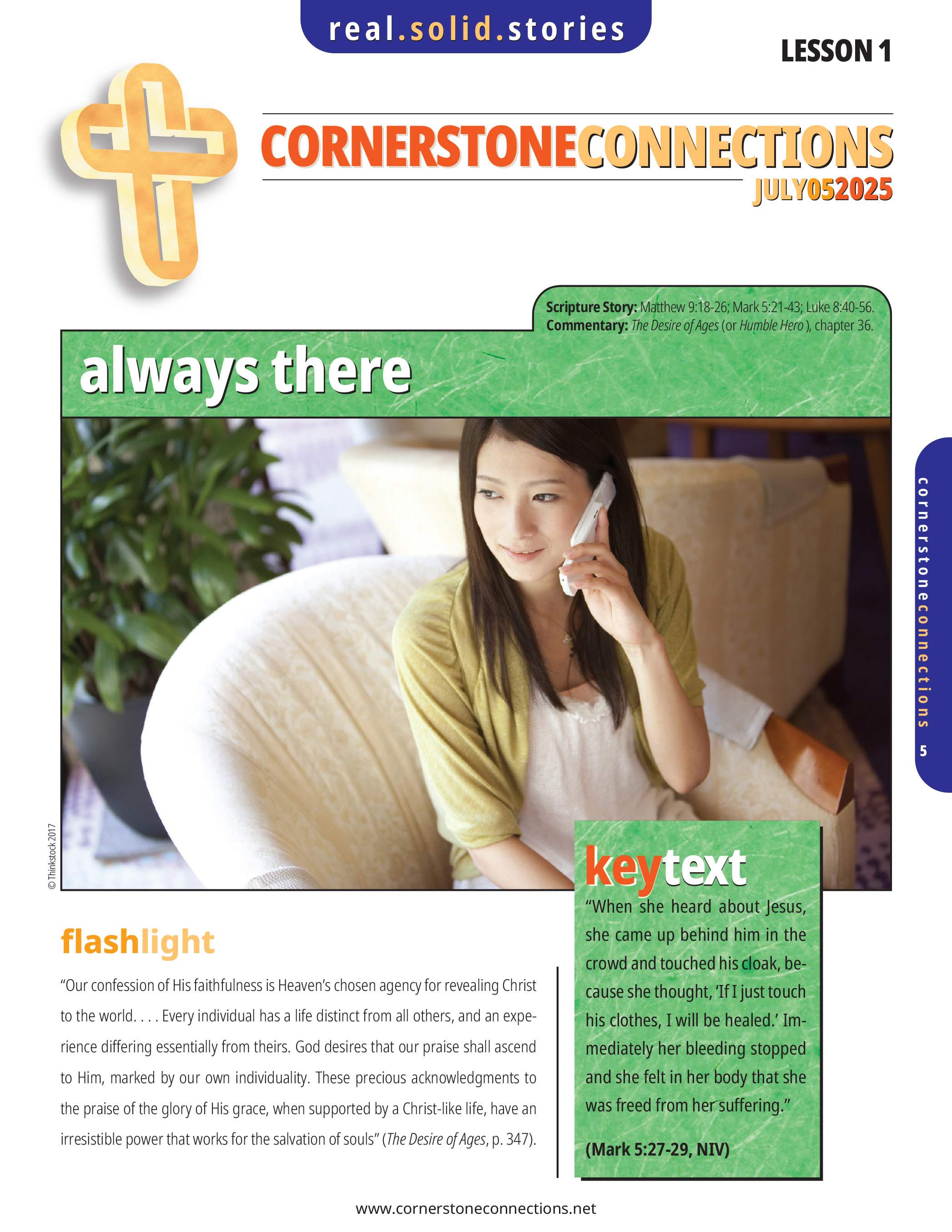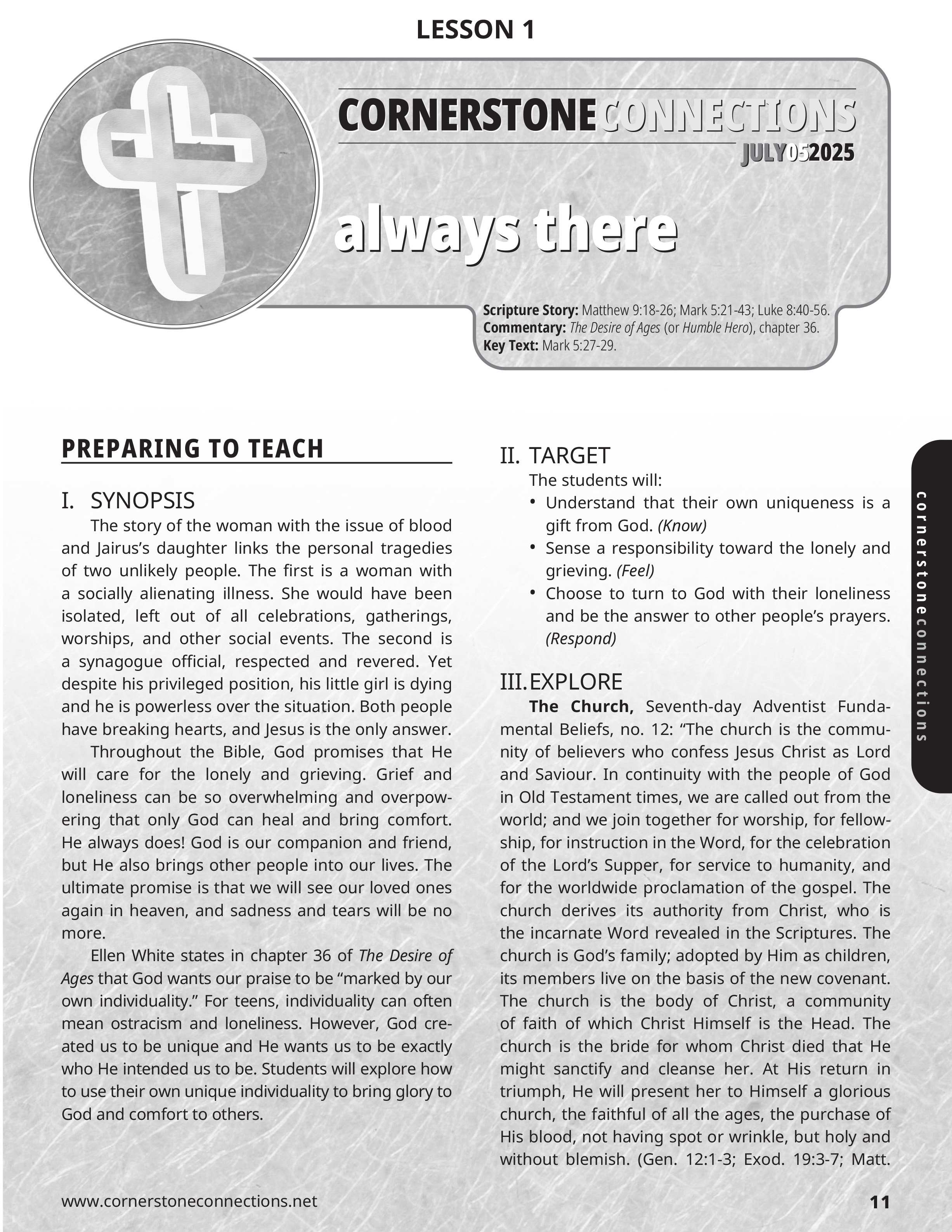Always There
Click below to download the Cornerstone Connections leader’s guide and student lesson. This week’s resources also include two lesson plans and a discussion starter video which offer different ways of looking at the topic. Each lesson plan includes opening activities, scripture passages, discussion questions, and real-life applications.
Personal tragedy is no respecter of persons. Whether you are a woman with health issues or a revered religious leader with a dying daughter, God can give comfort and healing —if we are willing to go to Him.
Humble Hero (Desire of Ages)
Chapter 36 - The Touch of Faith Brings Healing

As a result of this lesson students will learn that Jesus honors our faith, whether timid or bold, for ourselves and for others.
Items needed: Spoons, pencil, paper
Christine Miserandino, a woman who lives with the autoimmune disease lupus, developed the “spoon theory” metaphor while out to eat with a friend. When her friend asked about how she managed life with lupus, Miserandino handed her friend a handful of spoons. Each spoon represented a set task she had each day, requiring a set amount of energy to accomplish. Each time her friend mentioned a task—getting dressed, taking a shower, washing the dishes, walking the dog, buying groceries—she took a spoon back. When the spoons were gone, Miserandino explained, she was simply out of energy for that day.
Have two or three of your students, or as many as are interested, describe a typical day in their lives in detail, from getting up in the morning to going to bed at night. After that discussion, have your students make a list of different things they may do on a typical day that require energy. They may come up with a list similar to this:
Some tasks they may not think to list could be:
Hand one of your students a few spoons. For each task they list, have them give you or set aside one spoon. If they’ve neglected to include some of the rudimentary tasks like personal hygiene, ask if they’d like to use those spoons as well (for instance, they may want to shower before hanging out with friends). Explain that for someone living with chronic fatigue or related conditions, when they’re out of “spoons,” they’re out of energy, even if there’s much more they’d like to do that day. A person living with such conditions may say, “I’m all out of spoons” to explain that they’re simply sapped of energy.
This week’s lesson introduces us to two striking characters who do what it takes to get Jesus’ help, publicly and privately.
Jairus was a public figure, a synagogue leader, who, desperate to save his twelve-year-old daughter’s life, makes a public spectacle of himself, falling at Jesus’ feet before a crowd. The other person, a woman we know only by a description of her condition, is so full of fear and shame that she tries to be healed in secret—only for Jesus to praise and uplift her before everyone.
Jairus was a powerful figure in his community, but he knew real power when he saw it. As a leader in the community (likely Capernaum) synagogue, he may have been part of the group that asked Jesus to heal the centurion’s servant in Luke 7:1-10, urging Jesus that “This man deserves to have you do this, because he loves our nation and has built our synagogue” (verses 4-5).
Of course, Jesus doesn’t require us to deserve or earn His mercy and grace. He offers it freely, yet both honors our freedom of choice and asks us to exercise faith, no matter how small, in His transformative power.
Scholars and preachers often point out that this week’s Bible study is an example of a “sandwich” story. We first meet Jairus, and Jesus starts heading to his house to perform a miracle, then a whole new story—and miracle!—happens right in the middle.
The healing of the hemorrhaging woman is one of several instances in which Jesus embraces people that religious taboos had excluded from society. According to the Law of Moses, the woman’s persistent bleeding made her ritually unclean—for twelve straight years. The Bible tells us she’d exhausted her every resource for a cure, but the disease itself would have left her simply exhausted.
Like the Samaritan woman at the well, her shame made her an outcast, but the debilitating effects of her condition would have made that beside the point. The consistent loss of blood would have caused anemia, depriving her body of oxygen. She’d have been perpetually short of breath and exhausted, unable to perform any of the many chores that filled daily life, from gathering water at a well to washing her clothes. The effort required to push through a crowd to touch Jesus’ clothes would have been absolutely tremendous.
Though these two intertwined stories are each told in Matthew, Mark, and Luke, the curious thing is that the longest version is found in the shortest of those three books: Mark. Let’s take a look at the first part of this “sandwich” story.
Read Mark 5:21-34.
21 When Jesus had again crossed over by boat to the other side of the lake, a large crowd gathered around him while he was by the lake. 22 Then one of the synagogue leaders, named Jairus, came, and when he saw Jesus, he fell at his feet. 23 He pleaded earnestly with him, “My little daughter is dying. Please come and put your hands on her so that she will be healed and live.” 24 So Jesus went with him.
A large crowd followed and pressed around him. 25 And a woman was there who had been subject to bleeding for twelve years. 26 She had suffered a great deal under the care of many doctors and had spent all she had, yet instead of getting better she grew worse. 27 When she heard about Jesus, she came up behind him in the crowd and touched his cloak, 28 because she thought, “If I just touch his clothes, I will be healed.” 29 Immediately her bleeding stopped and she felt in her body that she was freed from her suffering.
30 At once Jesus realized that power had gone out from him. He turned around in the crowd and asked, “Who touched my clothes?”
31 “You see the people crowding against you,” his disciples answered, “and yet you can ask, ‘Who touched me?’ ”
32 But Jesus kept looking around to see who had done it. 33 Then the woman, knowing what had happened to her, came and fell at his feet and, trembling with fear, told him the whole truth. 34 He said to her, “Daughter, your faith has healed you. Go in peace and be freed from your suffering.”
“Fear not.” “Don’t be afraid.” However you translate it, this commandment appears in the Bible 103 times.
Jairus’ experience with Jesus was, to use a modern cliché, a roller-coaster. He begs Jesus to save His daughter. Jesus agrees—but they’re interrupted along the way by a different miracle. Then people arrive and tell Jairus to give up—his daughter is dead. But Jesus says, “No—the story’s not over yet.”
Read Mark 5:35-43
35 While Jesus was still speaking, some people came from the house of Jairus, the synagogue leader. “Your daughter is dead,” they said. “Why bother the teacher anymore?”
36 Overhearing what they said, Jesus told him, “Don’t be afraid; just believe.”
37 He did not let anyone follow him except Peter, James and John the brother of James.
38 When they came to the home of the synagogue leader, Jesus saw a commotion, with people crying and wailing loudly. 39 He went in and said to them, “Why all this commotion and wail-ing? The child is not dead but asleep.” 40 But they laughed at him.
After he put them all out, he took the child’s father and mother and the disciples who were with him, and went in where the child was. 41 He took her by the hand and said to her, “Talitha koum!” (which means “Little girl, I say to you, get up!”). 42 Immediately the girl stood up and began to walk around (she was twelve years old). At this they were completely astonished.
43 He gave strict orders not to let anyone know about this, and told them to give her something to eat.
Illness wears us down, not just physically, but mentally, emotionally, and spiritually as well. The trauma of watching their daughter die took a toll on Jairus and his wife’s mental health—which is why Jesus told Jairus, “Don’t fear.” Taking care of someone with persistent needs can be draining on family members as well—again, physically, mentally, emotionally, and spiritually.

LEADER’S NOTE
For a Relational Bible Study (RBS) you’ll want to get into the Scripture passage and encourage the youth to imagine participating in the story while it’s happening. Then you will be able to better apply it to your own situation today.
You will need to ask God for the Holy Spirit to be present as your small group discusses the questions (no more than 3-6 people in a group is recommended). Start with the opening question. It is a personal question and the answer is unique for each individual. There is no right answer and nobody is an expert here, so don’t be surprised when you hear different responses. You are depending on the Holy Spirit to be present and to speak through your group. Say what God prompts you to say, and listen to what others share.
Take turns reading the chapter out loud. Follow that with giving the students some time to individually mark their responses to the questions (a PDF version of the handout is available as a download). This gives each person a starting point for responding when you start to share as a group. Next, begin the discussion by asking the students to share what they marked and why on each question as you work your way through. Feel free to take more time on some questions than others as discussion warrants.
Encourage each person in the group to apply what is discussed to their personal lives and to share with the group what they believe God wants them to do. Then ask them to pray that God will help each of them to follow through in doing so. Remind them to expect that God will show them ways to live out the message of this passage in the coming week, and that they are free to ask others in the group to help hold them accountable.
Be sure everyone takes time for personal applications before you end your Sabbath School time together.
Three of the Gospels include this story, actually two parts of a story (Matthew 9:18-26, Mark 5:21-43, and Luke 8:40-56). It began with Jesus agreeing to go with Jairus to heal his dying daughter. A woman with a bleeding problem touched the hem of Jesus’ garment and slowed things down. In the meantime, Jairus’ daughter died. We’ll look at the story from Luke’s perspective.
Both Luke and Mark place this right after Jesus cleansed the demoniac on the eastern short of the Sea of Galilee. But our story this week stands in contrast to the Gentiles on the eastern side of the Sea of Galilee. According to Luke 8:40, when Jesus arrived on the other side of the lake, probably near Capernaum, the crowds received Him with open arms. Wouldn’t you rather be there? Apparently, lots of people felt that way since a crowd immediately pressed close to Him.
Jairus, the ruler of the synagogue, gets mentioned first. According to Luke 8:41, Jairus fell at the feet of Jesus and begged Him to go heal Jairus’ near-death daughter who was only 12 years old.
But another dynamic collided with this one. The crowd included a woman who had a menstrual flow for 12 years straight. According to Leviticus 15:23-27, she wasn’t allowed in the synagogue where Jairus was in charge. It also meant anyone she touched or who touched her would be unclean until going through a ritual purification, and then they would still be unclean for the rest of the day! And she was in the crowd—the crowd where everyone was bumping into everyone else. There was no social distancing protocol of six feet between people. She, like Jairus, was also desperate. But, as an outcast, she believed that simply touching the edge of His garment would heal her, and it did! She felt it instantly!
When have you been in a crowd?
Read Luke 8:40-56.
40 Now when Jesus returned, a crowd welcomed him, for they were all expecting him. 41 Then a man named Jairus, a synagogue leader, came and fell at Jesus’ feet, pleading with him to come to his house 42 because his only daughter, a girl of about twelve, was dying.
As Jesus was on his way, the crowds almost crushed him. 43 And a woman was there who had been subject to bleeding for twelve years, but no one could heal her. 44 She came up behind him and touched the edge of his cloak, and immediately her bleeding stopped.
45 “Who touched me?” Jesus asked.
When they all denied it, Peter said, “Master, the people are crowding and pressing against you.”
46 But Jesus said, “Someone touched me; I know that power has gone out from me.”
47 Then the woman, seeing that she could not go unnoticed, came trembling and fell at his feet. In the presence of all the people, she told why she had touched him and how she had been instantly healed. 48 Then he said to her, “Daughter, your faith has healed you. Go in peace.”
49 While Jesus was still speaking, someone came from the house of Jairus, the synagogue leader. “Your daughter is dead,” he said. “Don’t bother the teacher anymore.”
50 Hearing this, Jesus said to Jairus, “Don’t be afraid; just believe, and she will be healed.”
51 When he arrived at the house of Jairus, he did not let anyone go in with him except Peter, John and James, and the child’s father and mother. 52 Meanwhile, all the people were wailing and mourning for her. “Stop wailing,” Jesus said. “She is not dead but asleep.”
53 They laughed at him, knowing that she was dead. 54 But he took her by the hand and said, “My child, get up!” 55 Her spirit returned, and at once she stood up. Then Jesus told them to give her something to eat. 56 Her parents were astonished, but he ordered them not to tell anyone what had happened.
1. Why did the crowd on the other side of the lake welcome Jesus?
2. Why did Jesus go with Jairus to heal his daughter?
3. What best describes the woman who touched Christ’s garment?
4. Why did Jesus make a big deal about the woman touching him?
5. If you were Jairus, what would be your thoughts/feelings now (vs. 49)?
6. Why does Jesus refer to death as sleep?
7. When has Jesus done a miracle in your life? When has Jesus not done a miracle in your life and you really wanted (or needed) one?
8. In this story, would you rather be the woman Jesus healed, the daughter Jesus resurrected, or Jairus? Why?
What a unique juxtaposition of stories. Jairus wanted Jesus to heal his daughter because 12 years is not long enough for your child to live. For the unnamed woman Jesus called “Daughter,” 12 years was too long to be an unclean outcast.
In Jewish thinking, the number 12 symbolizes God’s kingdom. Think of the 12 tribes of Israel (and then the 12 disciples of Jesus). The breastplate of the high priest included the names of the 12 tribes engraved there. The table of showbread in the wilderness sanctuary had 12 fresh loaves of bread each Sabbath. When crossing the Jordan River into the Promised Land, the Israelites took 12 stones from the river and built an altar to Yahweh, plus another pile of 12 stones in the middle of the river as another memorial (Joshua 4:2-9). Generations later, Elijah rebuilt Yahweh’s altar on Mount Carmel by using 12 stones (1 Kings 18:31).
In the Garden of Gethsemane, the night Judas betrayed Christ, Jesus told His disciples He could have called 12 legions of angels to rescue Him (Matthew 26:53). If you want to see the highest concentration of the number 12 (and variants of it), read the description of the New Jerusalem in Revelation 21. The number 12 symbolizes God’s kingdom. Our passage of Scripture gives further evidence of God’s kingdom through healing the woman who had been bleeding for 12 years and the resurrection of Jairus’ daughter who was only 12 years old.
While God’s kingdom is still in the future, it also happens right now. Where do you see it? Where do you participate in it? Where do you spread it?
Here are a few application ideas for you to move from Sabbath School into action this coming week and beyond. Feel free to adapt this as the Holy Spirit moves you, but, by all means, apply this Scripture study to your life in the coming week and month.
Both Jairus and the unclean woman went on their knees to Jesus. This position of submission puts one at the complete mercy of the other. No wonder kneeling describes a common prayer position.
Back in the 90s and early 2000s, a new clothing line called “No Fear” marketed sports apparel especially for action sports such as dirt biking and skate boarding. Instead of seeking endorsements from sports heroes with hefty contracts, “No Fear” apparel went for catchy sayings promoting individuality, independence, and personal meaning. Although financial troubles hit, forcing them into chapter 11 bankruptcy in 2011, another group quickly bought them and they continue to this day. You don’t need the brand name. It actually predates this company by more than 2,000 years. It’s common in Old Testament writings, and Jesus gave this message to Jairus when news came that his daughter had died.
Imagine being Jairus and riding his roller coaster of emotions that day. He begged Jesus to go with him to heal his dying daughter. Jesus went with him. The woman with bleeding touched the hem of Jesus’ garment, which resulted in Jesus stopping and dealing with her. Then came news Jarius’ daughter had died. But Jesus encouraged Jairus to not be afraid, but just believe in Jesus. On they went. At the house, just a few could enter the room of the dead 12-year-old, including Jesus, Jairus and his wife, Peter, James, and John. After resurrecting the young daughter, Jesus told those few present NOT to tell anyone what happened. How could you do that? How do you explain this girl walking around after she had died?
Jesus often told those he healed not to tell others because of the resulting reaction to crown Him king to overthrow the Romans. Yet He had told the cleansed demoniac earlier in the chapter to go home and tell the other Gentiles what God had done for him and how He had mercy on him. Do you tell, or do you NOT tell? What has Jesus done for you?




